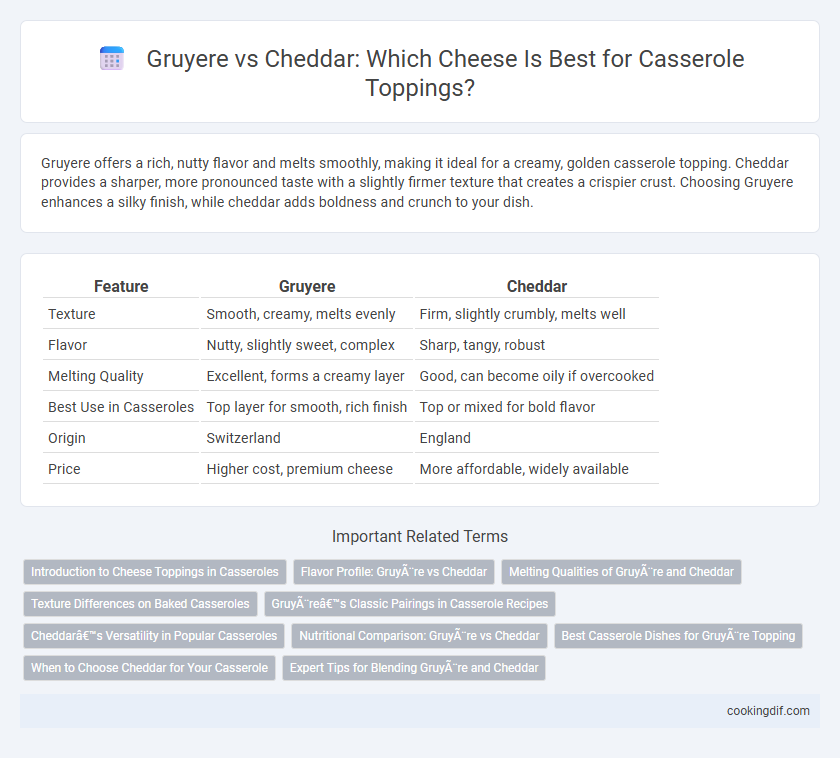Gruyere offers a rich, nutty flavor and melts smoothly, making it ideal for a creamy, golden casserole topping. Cheddar provides a sharper, more pronounced taste with a slightly firmer texture that creates a crispier crust. Choosing Gruyere enhances a silky finish, while cheddar adds boldness and crunch to your dish.
Table of Comparison
| Feature | Gruyere | Cheddar |
|---|---|---|
| Texture | Smooth, creamy, melts evenly | Firm, slightly crumbly, melts well |
| Flavor | Nutty, slightly sweet, complex | Sharp, tangy, robust |
| Melting Quality | Excellent, forms a creamy layer | Good, can become oily if overcooked |
| Best Use in Casseroles | Top layer for smooth, rich finish | Top or mixed for bold flavor |
| Origin | Switzerland | England |
| Price | Higher cost, premium cheese | More affordable, widely available |
Introduction to Cheese Toppings in Casseroles
Gruyere and cheddar serve distinct roles as cheese toppings in casseroles, with Gruyere offering a creamy, nutty flavor and excellent melting properties, while cheddar provides a sharper taste and a more robust texture. Gruyere enhances a casserole's richness and browns evenly to form a golden crust, ideal for gratins and baked pasta dishes. Cheddar's bold flavor profile and firmer melt make it suitable for casseroles requiring a pronounced cheese presence, such as macaroni and cheese or potato bakes.
Flavor Profile: Gruyère vs Cheddar
Gruyere offers a rich, nutty flavor with a smooth melting texture that enhances casseroles with a subtle complexity, while cheddar provides a sharper, more pronounced tanginess that adds boldness and depth. The creamy, slightly sweet notes of Gruyere complement vegetables and delicate proteins, contrasting with cheddar's robust, earthy undertones that stand out in hearty, meaty dishes. Choosing between Gruyere and cheddar depends on whether a mild, sophisticated taste or a strong, savory punch is desired for the casserole's cheese topping.
Melting Qualities of Gruyère and Cheddar
Gruyere melts smoothly and evenly, creating a creamy, velvety texture ideal for casserole toppings. Cheddar, while flavorful, often becomes oily and separates when melted, leading to a less consistent texture. The superior melting qualities of Gruyere ensure a rich, cohesive layer that enhances both taste and presentation.
Texture Differences on Baked Casseroles
Gruyere offers a smooth, creamy texture with a slightly elastic melt that forms a rich, golden crust on baked casseroles, enhancing the dish's overall silkiness. Cheddar tends to create a firmer, less elastic topping that crisps up more prominently, providing a sharper, crumbly finish. The choice between Gruyere and cheddar affects the casserole's mouthfeel and visual appeal, with Gruyere delivering a velvety melt and cheddar offering a robust, textured bite.
Gruyère’s Classic Pairings in Casserole Recipes
Gruyere cheese offers a rich, nutty flavor and smooth melting quality that makes it ideal for casserole toppings, especially in classic pairings with ingredients like potatoes, mushrooms, and onions. Its complexity enhances the savory depth of dishes such as French onion casserole and gratins, providing a sophisticated taste profile that cheddar often lacks. While cheddar delivers sharpness and boldness, Gruyere's creamy texture and subtle sweetness elevate casseroles to a gourmet level.
Cheddar’s Versatility in Popular Casseroles
Cheddar cheese offers exceptional versatility in popular casseroles, enhancing dishes like macaroni and cheese, broccoli casserole, and baked potatoes with its sharp, creamy flavor that melts smoothly. Unlike Gruyere, which imparts a nutty, slightly sweet taste best suited for specific recipes like French onion casserole or gratins, cheddar adapts easily to a range of textures and flavor profiles. Its wide availability and flavor strength make cheddar the preferred choice for comfort foods that require a rich, gooey melted cheese topping.
Nutritional Comparison: Gruyère vs Cheddar
Gruyere cheese contains approximately 413 calories and 33 grams of fat per 100 grams, offering a rich source of calcium and protein, which supports bone health and muscle maintenance. Cheddar cheese has a slightly higher calorie count at 402 calories and 33 grams of fat per 100 grams, but provides more vitamin A and phosphorus, essential for vision and energy metabolism. Both cheeses offer beneficial nutrients for a casserole topping, though Gruyere is lower in sodium compared to cheddar, making it a better option for those monitoring salt intake.
Best Casserole Dishes for Gruyère Topping
Gruyere cheese offers a rich, nutty flavor and excellent melting qualities, making it ideal for topping creamy potato or chicken casseroles that benefit from a golden, bubbly crust. Unlike cheddar, which has a sharper taste and can separate under heat, Gruyere maintains a smooth texture and enhances the savory depth of vegetable or mushroom-based casseroles. Classic dishes like French onion casserole or Swiss-style broccoli gratin showcase Gruyere's ability to add luxurious creaminess and a sophisticated finish.
When to Choose Cheddar for Your Casserole
Cheddar cheese offers a sharp, tangy flavor that intensifies during baking, making it ideal for casseroles needing a bold taste profile. Its excellent melting properties and creamy texture create a rich, gooey topping that complements hearty ingredients like chicken, beef, or vegetables. Choose cheddar when you want a robust cheese flavor that balances savory casseroles and delivers a satisfying, golden crust.
Expert Tips for Blending Gruyère and Cheddar
Experts recommend blending Gruyere and cheddar for casserole toppings to balance flavor complexity and meltability; Gruyere offers a rich, nutty taste while cheddar provides sharpness and a smooth texture. A common ratio is two parts Gruyere to one part cheddar, enhancing both creaminess and depth without overpowering the dish. Using shredded cheeses rather than pre-sliced ensures even melting and optimal browning for a golden, flavorful crust.
Gruyère vs cheddar for cheese topping Infographic

 cookingdif.com
cookingdif.com